by Tess Machling, Roll Williamson & Mark Randerson
[A download/print PDF version of the paper & Appendix 1 can be found at the end of the paper]
This paper can be cited as: DOI 10.5281/zenodo.10973036
Abstract
The Knaresborough ring is a unique find. Found in 1994 in Knaresborough, Yorkshire, the ring is made from sheet gold and displays many characteristics typical of Iron Age goldwork. However, the form of the ring is not typical of the period and corresponds most closely to Scandinavian-influenced ‘rings’ of the later 9th and early 10th centuries.
It is proposed that the ring was derived from an Iron Age hoard, discovered, modified, broken up and re-deposited later, at the time of micel here (Great Army) activities/the Danelaw in the late 9th/earlier 10th centuries. The areas of Nottinghamshire, Yorkshire and Lincolnshire have already produced apparently Viking-modified Iron Age goldwork from this period (Machling & Williamson 2018b, 2018c).
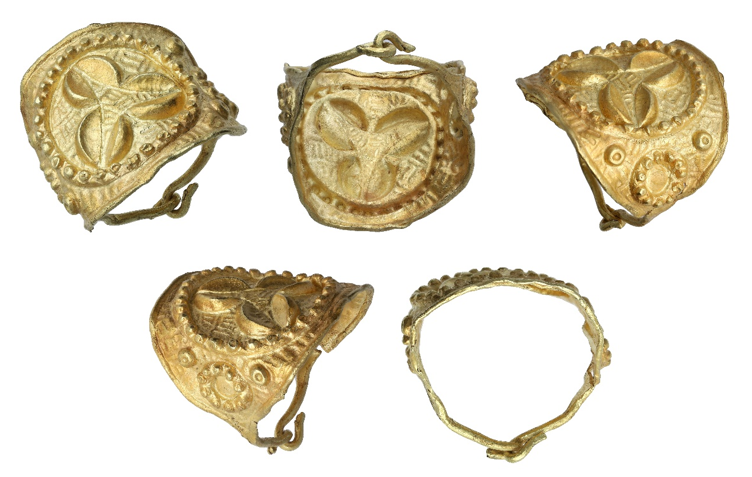
Introduction
On 10th November 2022, an article in ‘The Times’ newspaper (Blackburn 2022) announced the auction sale of an unusual, apparently Iron Age, gold ring (Fig. 1). This article was noticed by one of the authors (RW), and both the British Museum and the Yorkshire Museum were contacted by TM.
The ring, measuring 25mm wide by 22mm in diameter, and weighing only 5.41g, was made from highly decorated sheet gold and was described by Noonans Auction house (Noonans 2022; Lot No 1518) as,
“Celtic, a gold finger ring, c. 100 BC, 22mm diameter, bezel 25mm wide, 5.41g; formed from sheet gold and die-hammered from behind (repoussé) creating in high relief a trefoil shape from three pairs of crescent lips in the centre of the large oval bezel, bordered by a ring containing twenty-nine equally spaced pellets; the sloping and tapering shoulders are decorated with a central berried rosette flanked by annulets on each side; the field is entirely decorated with broad cross hatching or basketry infilling which is a secondary punching made from the front of the ring; the narrow hoop is circular in section and looped together at the back. Extremely fine but with a tear across part of the lower edge.
Provenance: Found at Knaresborough in 1994 and declared to the North Yorkshire coroner under the Treasure Trove law where it was declared a stray find and therefore not Treasure. The British Museum examined the ring, suggesting it was from the Snettisham workshop, which highlights its importance as the only surviving finger ring of this style. It has been in a private collection since that time, and this is the first time it has been offered for sale at auction.
Gold in Iron Age Britain had been used conservatively in the 3rd and 2nd centuries BC, but British tribal nobility revived its importance and status during the 1st century BC. This ring represents the Snettisham style V ornamentation (from the hoard of gold torcs and armbands found in Norfolk in 1948) which is a distinctive abstract British style that has become synonymous with the royal treasury of the Iceni tribe that ruled a large part of East Anglia. The execution and refinement of the sheet gold work from Snettisham is unparalleled on the continent.
In Yorkshire bronze workshops from the 3rd century BC are thought to have developed the style of art which peaked with the Snettisham ateliers. Die-stamped Brigantian artistry can be seen on the 1st century bronze hoard from Stanwick in Yorkshire. The trefoil design also appears on coinage (a North Eastern Corieltauvi gold stater) and is believed to be inspired by the three-leaved clover. The rosette or petalled sun ring also appears on silver units of the Corieltauvi tribe. It is likely the Knaresborough ring was worn by a Corieltauvi chieftain along with a neck torc and armbands as a symbol of his high status.”
The ring was given an auction estimate of £24,000 to £30,000. Attempts by the Yorkshire Museum to purchase the ring were unsuccessful and the item went under the hammer at £36,000 – and into private hands. Requests by TM to examine the ring for research were turned down and now, at the time of writing and despite assurances to BBC Yorkshire that the ‘the buyer now wanted to loan the ring so the public could view it’ (BBC Yorkshire 2022) the current whereabouts of the ring are unknown.
Part 1: The Knaresborough ring and Iron Age parallels
Discovery of the ring
The ring was discovered in 1994 and reported to the coroner and subsequently the British Museum. The British Museum’s report from 1994, uploaded to the Portable Antiquities Scheme (PAS) online database in May 2023 (BM-CDF17E) notes that ‘the owner… had recently purchased the find believing it to have been found in the Knaresborough area in North Yorkshire. It was said to have been an isolated find.
The coroner reported that ‘no information was available regarding the precise location of the find and the circumstances in which it was discovered’ (PAS BM-CDF17E). However, in line with other PAS finds – where find spots are self-reported – there is no reason to believe that the general findspot of Knaresborough is inaccurate. As the ring was recovered before the Treasure Act of 1996, which replaced Treasure Trove in England and Wales, the ring was returned to the finder. Under current laws the ring would have been declared Treasure and likely purchased by a museum as a find of national significance.
The ring was examined by Dr Ian Stead and Dr Valerie Rigby of the British Museum in 1994. In early October 2022, a further email exchange took place between the British Museum and the owner/Noonans, immediately prior to the listing of the ring in the Noonans auction catalogue. On 19th May 2023, at the request of the authors, the previously unpublished British Museum report of 1994 was uploaded to the PAS database (PAS BM-CDF17E: PAS 2023).
Despite being in receipt of the 1994 British Museum report, the auction listing is clearly fanciful; there is no evidence for its wearing by ‘Corieltauvi chieftains’, or any relationship of the ring with ‘tribal nobilities’ or ‘royal Icenian treasuries’. The decorative description, weight and size of the ring would, however, appear to be accurate, and is corroborated by the 1994 British Museum report. But with such unproven contextual and biographical information included in the auction catalogue it is important to look at the ring from an archaeological perspective.
It should be noted that the ring has not been examined in person by the authors, for the reasons outlined above. Discussion points in this paper are solely based on attributes which can be clearly observed in third-party photographs. It is therefore possible that direct examination of the ring might result in the discovery of additional evidence.
Preservation
In terms of preservation, the ring shows expected levels of wear and tear (cracking, slight distortion, etc) for an Iron Age gold item. Interestingly, the gold of the Knaresborough ring shows stress cracks typically found in Iron Age gold working, and which seem to have been exacerbated by post-depositional chemical/mechanical action (Fig. 6). This has also been observed on the Near Stowmarket torc terminal fragment (Machling & Williamson 2020b).
Ring description
Made from a lozenge of decorated gold sheet, the bezel tapers to hammered, round-section wire at the back, and is secured with two hooks, created by turning over the ends of the wires. The ring, in its current form, would appear to be complete and is highly unusual.
As mentioned previously, the ring is described as being ‘22mm diameter, bezel 25mm wide, 5.41g’ in the Noonans catalogue listing (Noonans 2022; Lot No 1518). The 1994 British Museum report (PAS BM-CDF17E: PAS 2023) contains no measurements or a weight for the ring, but there are three, poor quality, photographs. As such, the Noonans catalogue measurements and photographs are all that are available. It is likely that they are accurate, as poor measurements and photographs would detract from a successful sale. An analysis by the British Museum (method unspecified) of the alloy composition is given as 74.8% gold, 19.6% silver and 5.6% copper, a composition that would not be out of character for Iron Age gold. Despite our not being able to see the ring, the Noonans measurements – and photographs – and the British Museum alloy analysis, when taken together, provide a convincing – albeit limited – account of the ring.
Iron Age rings
Iron Age finger-rings are extremely rare. Across Britain, only seven Iron Age gold rings are recorded in the Portable Antiquities Scheme database (PAS 2022) from Witham, Essex (PAS ESS-015996); Chislet, Kent (PAS KENT-5235BB); Edworth, Bedfordshire (PAS DENO-D90604); Kineton, Warwickshire (PAS WAW-790135); Yoxall, Staffordshire (PAS WMID-BCA708), ‘Near Lincoln’, Lincolnshire (PAS NLM-81834F) and Frodesley, Shropshire (PAS WAW-E89F0E). All these are plain and made from a single gold wire hoop bent into a ‘V’-shape (Fig. 2). The diameter of the Knaresborough ring is slightly larger in diameter than the ‘V’-shaped examples, which tend to measure between c.15-20mm diameter, whereas the Knaresborough ring is 22mm.
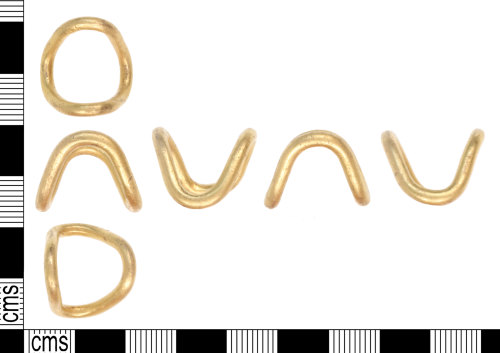
A handful of other examples of ‘V’ form rings, e.g. the silver ring from Park Brow, Sussex (Jope 2000, pl.45p), are known from other sources. Two other types of gold ring (four rings in total) are known from the Câtillon II hoard in Jersey (Fitzpatrick pers. comm.) and from Arras, Yorkshire (Jope 2000, pl.45d) but although they are slightly more complex in form, they are created from single wires only, bent into simple forms (Fig. 3). Even in continental Europe, where relief-decorated, thicker, band forms are more typical, gold rings are scarce in the later Iron Age (Fitzpatrick pers. comm.).
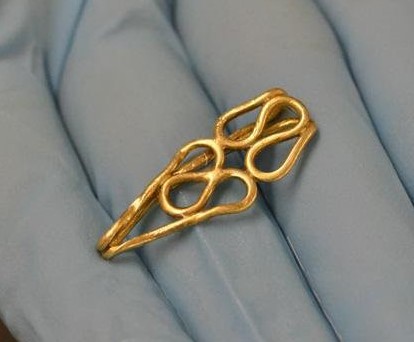
The Knaresborough ring, being of a broader bezel form with a thin wire ring-body and closing hooks does not conform to any known Iron Age ring type from Britain, Ireland or Europe.
Decoration
The decorative arrangement itself is unique in a gold artefact: the smaller ‘berried rosettes’ on the sides of the bezel are of particular note as these have never before been seen on Iron Age decorative goldwork, and are more usually – in a slightly different form, with a central ‘dot’ – to be found on copper-alloy items, for example, on the Ringstead (Fig 4), (Norfolk) and Ulceby, (north Lincolnshire) bits and the Hod Hill (Dorset) strap fitting (Jope 2000, pl. 127).

Such motifs, with a central dot, are also known from Iron Age gold coinage. However, the coinage of, for example, the Corieltavi (see IACIB Numbers: ABC 1797, 1800, 1803), shows a similar ring without a central dot. Taken together, the distribution of the coinage and copper-alloy finds suggest that the Knaresborough ring may have its origin in the east/north east of England.
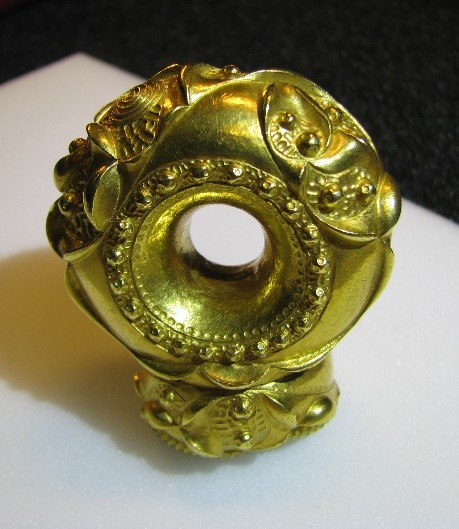
The larger circle of raised dots on the face of the Knaresborough ring echoes the small ‘berried rosettes’ on the sides of the ring bezel. This precise decorative feature is again unknown in Iron Age goldwork, although a similar circle of, albeit triple punched and larger, raised ‘dummy rivets’ can be seen on the face of the Netherurd (Feacham 1958) torc terminal from Peeblesshire, Scotland (Fig. 5).
Raised ‘dummy rivets’ are common in ‘Snettisham Style’ goldwork and can be seen on the majority of gold Iron Age torcs. However, the four raised ‘dummy rivets’ on Knaresborough, arranged two each on the bezel sides, are punched with single dots and this decoration is rare for the ‘Snettisham Style’, where three dots are typical.

The only other gold examples of a single punched dot can be found on the three surviving ‘dummy rivets’ of the Near Stowmarket terminal fragment (Fig. 6) from Suffolk (Machling & Williamson 2020b) and on only one – of the twenty-two – ‘dummy rivets’ on the Snettisham Great torc.
The other decorative elements – for example, the raised semi-circular lozenges, three-part central design and ‘basketwork’ linear tooled punching – are typical of the ‘Snettisham Style’, and are of similar dimensions to decorative elements that can be seen on a number of gold torcs. These include the Snettisham Great (Fig. 7) and Sedgeford torcs from Norfolk (Brailsford 1971), the Newark torc from Nottinghamshire, the Clevedon terminal from Somerset and the Netherurd terminal from Peeblesshire in Scotland. However, the Knaresborough ring is the only gold artefact that is not a torc to display this decorative style.

Although displaying many of the classic ‘Snettisham Style’ aspects, the Knaresborough ring’s symmetrical layout and unconnected decorative motifs is unusual. In gold work, such symmetry can only be seen on the stylistically ‘early’ Snettisham Grotesque torc (Brit. Mus.: 1991,0407.37), Snettisham Bracelet (Brit.Mus.: 1951,0402.4), the Snettisham mini-Grotesque (Brit. Mus.: 1991,0501.45) torc terminal and a handful of other torc pieces from Snettisham. The flowing connectedness of the typical ‘Snettisham Style’ is absent, with all elements on the ring arranged separately on the panel: the linking swags, keeled volutes and keeled roundels typical of ‘Snettisham Style’ are entirely absent.
The central tri-partite motif formed from six raised semi-circular segments is not seen in any other object of this date, however, it recalls two torcs from Snettisham (Brit. Mus.: 1991,0407.60 & 1991,0501.163) which instead have a central triangular panel formed from three similar segments, on the face of one buffer terminal, and on the collar of another (Fig. 8).

The wire hook closing method is not common in Iron Age goldwork, but is reminiscent of the closing mechanism seen in Iron Age Ribbon torcs, such as those from Law Farm (NMS: X.FE 67) or Blair Drummond (NMS: X.2011.6.4) in Scotland. However, these usually have some form of ‘button’ or expanded terminal at the wire end. It is also similar to the hooks seen on Bronze Age sheet strips/Ribbon torcs. Beyond these very different, and much larger, gold neck/arm rings the double hook is unknown in the Iron Age, whereas rings with hook fastenings are a known Viking-Age form (discussed below).
Manufacturing method
The ring is made from sheet gold and the method of manufacture can clearly be seen, even from photographs, and is not as described by Noonans. The method is again as yet unknown in wider Iron Age metalworking, but typical of gold sheet torcs of the period (Machling & Williamson 2018a, 2019a, 2019c, 2020a). The production of torcs utilizes an unusual technique, not seen in other prehistoric metal sheet working (Machling & Williamson 2020a, 91). Repoussé is the standard method of sheet decoration in copper-alloy. This technique which raises relief from the back of a piece – as can be seen on such items as the Battersea shield (Brit. Mus.: 1857,0715.1) and Torrs Pony Cap (NMS: X.FA 72) – is not, however, the primary gold working technique used in gold sheet torcs.

Instead, a technique akin to the Japanese traditional metalworking method of uchidashi (Katori et al 2006) – where relief is created by largely working from the front – is used in sheet gold torcs. In Britain, this technique has so far only been identified for Iron Age goldwork and not for other periods. Uchidashi results in blurred, rather than crisp, obverse relief motifs on the back of a worked piece as can be seen on the Netherurd [Scotland] (Fig. 9), the Near Stowmarket [Suffolk] and the Clevedon [Somerset] terminals (Machling& Williamson 2019c). That the Knaresborough ring also shows such a technique (confirmed in PAS report BM-CDF17E), with similar thickness gold sheet (from Noonans auction catalogue photographs, estimated to be c.0.5mm thick) offers proof that the ring could be comfortably situated within the wider suite of Iron Age gold sheet worked artefacts.
Object biography
Recent research on Iron Age gold torcs has shown that a number of these items were reworked, repurposed and reconfigured in the Iron Age (Machling & Williamson 2019a; 2019b; 2020a). For example, the Clevedon torc terminal, now a capped buffer terminal, would appear to have been cut down from the torus torc collar of a Netherurd/Snettisham Great torc type (Fig. 10) (Machling & Williamson 2019b). We believe that the Knaresborough ring also shows evidence of modification.

In examining the Knaresborough ring, it is possible that this item was made from a reworked terminal collar, for the following reasons: The Knaresborough ring is made from sheet gold, about 0.5mm thick. This compares favourably with the c.0.7mm sheet thickness of torus torcs. In addition, the decorative elements are of similar form and size to those seen in torus torcs. The uchidashi manufacturing technique would also appear to be similar.
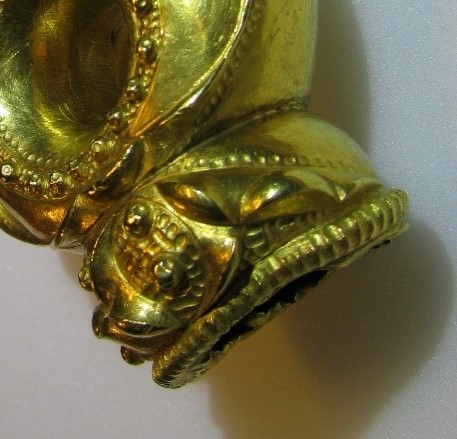
The suggestion of the authors is that the Knaresborough ring was, like the Clevedon torc terminal, created from a piece of torus torc collar. The recorded width of the bezel, of 25mm, would support such a theory, comparing favourably with the Snettisham Great torc (Fig. 10) collar height of 21.3mm. The full Knaresborough ring circumference (including tip-to-tip wire ring measurement) would result in a similar collar diameter to the c.32-34mm aperture diameter of known torus torcs, such as the Snettisham Great torc and the Netherurd terminal (Fig. 11).
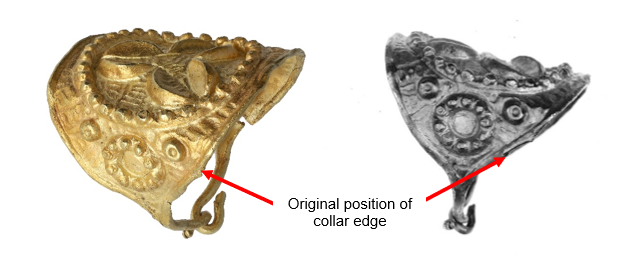
In addition, the slightly asymmetric positioning of the wire ring in the Knaresborough example (Fig. 12) would suggest that the utilized panel (as in the Snettisham Great torc and Netherurd terminal) rose at the front of the collar, tapering down to the base-edge of the torc collar on the sides, as can be seen on the Netherurd terminal in Fig. 11. The folded edges seen on the ring (see PAS report BM-CDF17E) would conceal the cut edges.
As such the ring might represent a cut away panel of decoration, with the ring and closing hooks hammered into wire from the lower edge of the torc collar. However, when this re-modelling took place is unknown and, as has been previously noted, the style of the ring is not a known Iron Age type. Therefore, could the re-modelling of the Knaresborough ring have taken place at a time later than the Iron Age?
Part II: The Knaresborough ring as a rediscovered and redeposited object
Previous work by two of the authors (Machling & Williamson 2018b & 2018c) has suggested the possible modification and re-deposition of several Iron Age gold torcs in the later 9th and earlier 10th centuries across the north and east of England. The find spot of the ring in Knaresborough, Yorkshire, would fit this pattern of finds from the vicinity of Yorkshire, Lincolnshire and Nottinghamshire.
The reappropriation of earlier archaeological material in later periods is well documented (Knight et al 2019) and so it should not come as a surprise that Iron Age gold could be re-used more than 1000 years after its deposition. In this section, we explore the evidence that supports the idea that the Knaresborough ring was an object rediscovered in the Viking period.
The Newark torc and other nicked torcs
In 2005 an Iron Age gold torus torc was found by a detectorist in Newark, Nottinghamshire. This torc has a pronounced cut on the back of one terminal. Described by Dr J.D. Hill on the Portable Antiquities Scheme database as ‘an ancient gash or cut 5 mm long and 2 mm wide’ (PAS 2005) there was no further examination of this feature during the Treasure Act process or within subsequent publications (e.g. Atherton 2016).
The gash is clearly a very deliberate mark, made with force, but which did not distort or dent the surrounding gold. It does not look like post-depositional damage and is unlikely to be accidental, as explored below. Various explanations have been posited – including a rather bloodthirsty idea of the torc wearer’s neck being cut – but none is entirely satisfactory.
The gash on the torc is large, some 5mm by 2mm and around 1mm deep (Fig. 13). It comprises a deliberate linear incision, the cut of which has come in at slight angle from a direction going towards the wires and has caused a bulbous area of gold to develop on the opposing side of the cut. Having carried out experiments with a variety of knives on wax it must have been achieved by a very thin, and very sharp, blade. In profile the cut is ‘V’ shaped.
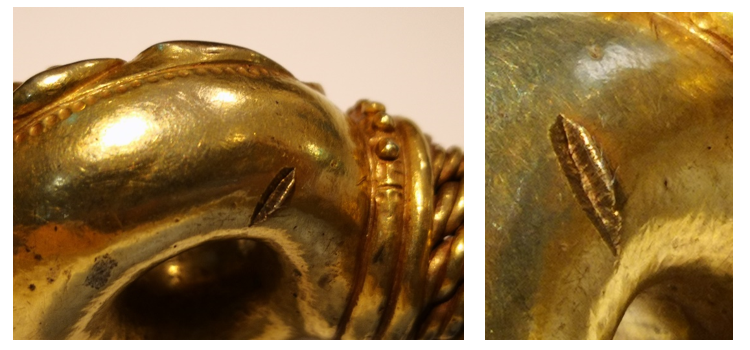
Such an incision is difficult to create from a percussive blow, and neither is it correct for a sawing action. The nature of the cut suggests that the gash was made by a very controlled action: the incision of a blade, which was then deliberately twisted or turned to open the cut to a ‘V’, the action of which caused the thickening of the gold on the opposite side of the entry point of the incision (Fig. 13, right).
There is no evidence to suggest that this gash was likely to have been created in prehistory, nor is there evidence for such practices in Britain and Ireland in the Roman or earlier Saxon periods. However, in Britain and Ireland, ‘nicked’ metal items are regularly seen in Scandinavian-derived assemblages (Kershaw 2019, Kruse & Graham-Campbell 2011, 79) and, although a far more common practice with silver, there are also examples of nicked gold work, such as the gold Viking-Age armlet from York (PAS YORYM1267) (Kershaw 2020, 117) (Fig. 14).
The practice (for discussion, see Kershaw 2019; 2020, 241) appears to have been carried out as a test of the item’s metal purity; by opening up a nick in the metal, any evidence of gilding, or plating, could be easily seen and the texture of the metal felt. It is also possible that such a technique became a kind of hallmark of quality that could be easily examined if the item was traded.

Others have suggested that the marks may have been a kind of trading mark, added each time the item changed hands, or that the nicking became a kind of ritualized action whose practical necessity was the least important element of the nicking. Indeed, there are several silver ingots that show large amounts of nicking far beyond that which would be practically needed (Fig. 15).

By comparing the nature of nicks in known Viking-Age examples to the Newark torc there does seem to be a close similarity between other early medieval nicked objects and the gash seen on the torc.
To establish whether or not other torcs had such nicks further searches were carried out. Within the PAS records, a torc piece from Caistor/West Lindsey, Lincolnshire (PAS NLM-605352) was also recorded as having been nicked. In his PAS report, Martin Foreman notes that there are ‘nicks noted on the band [which] are a familiar feature of hacksilver ingots and objects’ (Foreman 2013). In addition, Foreman notes that the torc has been broken and the remaining piece weighs an amount that corresponds with ‘8.06 Viking Dublin weights of the standard module for bullion calculated for Viking-Age Dublin: of 4.43gms’ (Foreman 2013). Furthermore, a domed lead weight (or potentially a gaming piece) was found close to the torc findspot, on the same day.
Such weights are thought to have been made by Viking forces and are closely linked to the Great Army (see for example, the weights/gaming pieces from the Torksey winter camp which appear to have been made on site (Blackburn 2011, 241)). The search also brought to light one of the two Towton torc armlets from North Yorkshire (PAS SWYOR-CFE7F7, York. Mus.: YORYM_2011_300) which appears to show a nick on the back of one terminal – in the same place as the Newark torc nick. From further photographs, supplied by the Yorkshire Museum, the nick can clearly be seen, similar in form to that located on the Newark torc (Fig. 16).
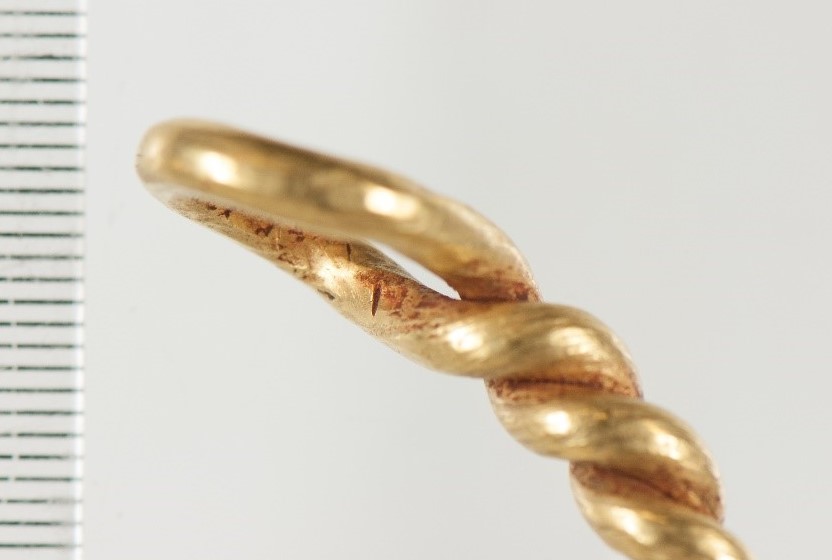
A search of the PAS records for ‘gold wire’ produced a scatter of Iron Age – likely torc-related – gold wire finds from for example, Blyth (PAS SWYOR-CBC05F) in Nottinghamshire and Garton in the East Riding of Yorkshire (PAS LANCUM-9FB182), but these pieces were undiagnostic and in no greater concentration than can be seen in casual loss Iron Age finds from across much of England. There are, however, pieces of faceted, hammered wire from the Viking-Age Watlington Hoard (Naylor & Stanley 2022, 26) and a longer piece (45mm long) from a findspot designated ‘Brampton’ (PAS SWYOR-C74077) in Lincolnshire which would match any number of gold wire torc pieces from the Iron Age Snettisham hoards (for example, Brit. Mus.: 1991,0501.79; 1991,0501.126; 1991,0501.155; 1991,0501.192 & 1991,0407.47) and which show comparable twist, faceting and wire diameters.
Of particular interest, the possible Iron Age wire piece from ‘Brampton’ – alongside a cut section of Scandinavian-influenced lozengiform ring – is from within the Torksey winter Viking Great Army camp (Hadley & Richards forthcoming), and this wire find might suggest that Iron Age goldwork was being disassembled/reworked on this site.
Apart from the cut-marked torcs of Newark, Caistor/West Lindsey and Towton, the hoard of Ulceby (Fox 1958, 37), Lincolnshire, is the only other Iron Age torc hoard within the vicinity of these other finds. However, this last was from an apparently undisturbed secure context including gold torcs and bronze horse bits etc, buried together. As it has no evidence of disturbance or modification after its initial deposition, this hoard was disregarded for the purposes of this paper (it should be noted that these items have not been seen by the authors). Other gold finds are present in the area from, for example, the Iron Age cemeteries of the Yorkshire Wolds, but these again have secure and undisturbed Iron Age contexts.
After searching nearly 10,000 photographs of our own, and multiple online catalogues of the more than 300 represented torcs found across Britain and Ireland, the only Iron Age torcs with evidence of possible later modification by cut-nicking are the Caistor/West Lindsey torc piece, the Towton torc armlet and the Newark torc – all of which were found within an approximate area measuring 110km by 60km towards the north east of England, an area of intense Viking activity in the 9th and 10th centuries (Fig. 21). In addition, the nature of the deposits and find spots of these torcs, if compared to other torc finds, are unusual.
Iron Age torc hoards
Typically, beyond the Snettisham site in East Anglia – which has more than 200 nested and broken torcs (Joy 2018) – most torcs are found in groups of around three or four torcs buried in apparently isolated locations and often on slight rises or slopes, for example: the hoards from Leekfrith (Farley et al 2018) and Alrewas in Staffordshire, Ipswich in Suffolk (Brailsford & Stapley 1972), Clevedon in Somerset, Netherurd in Peeblesshire (Feacham 1958) and Blair Drummond in Stirling (Hunter 2018) (Fig. 17).

Single torc finds are known, although these tend to occur in Norfolk or within a defined and isolated group of depositions in Staffordshire, where a number of single torcs have been found clustered in the Tamworth area (the Glascote (Painter 1971), Middleton Hall (Brit. Mus.: 1977,0401.1) and Needwood Forest (Hawkes 1936) torcs). However, none of these single torcs are nicked and their deposition may relate to activity around the time of the Icenian revolts in the mid to late 1st century (Machling & Williamson forthcoming), although another scenario of later discovery and re-deposition cannot be ruled out entirely.
In the case of the Newark torc, the finding of the torc on its own, in such a low-lying location close to a river, even led some to speculate that the torc had been removed from elsewhere before being declared. Similarly the finds of the Towton torcs in a stream bed, and the Caistor/West Lindsey torc found close by a Torksey-type lead weight/gaming piece, were not found with typical Iron Age torc deposition associations.
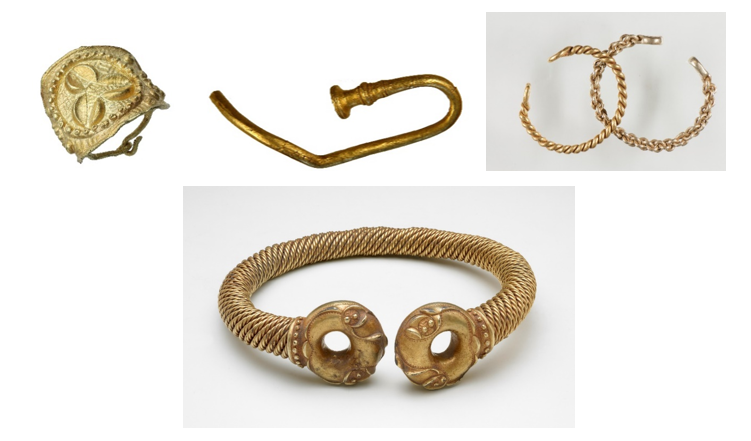
However, if the Newark torc, the Caistor/West Lindsey torc, and the two Towton torcs are put together, this find – of a complete torus torc for the neck, two smaller arm torcs and perhaps a complete ‘thistle-head’ terminal torc – would be a perfectly standard torc hoard collection and would compare favourably to Netherurd (three smaller torcs, a detached terminal and forty gold coins), Leekfrith (three neck torcs and one bracelet), Blair Drummond (three neck/arm torcs and a broken piece of neck ring) and Ipswich (five/six neck torcs).
It would also not be surprising, as with the Netherurd and Clevedon hoards, to find such a hoard also contained a detached torc terminal, which could be the origin of the Knaresborough ring.
Viking gold
Traditionally, Scandinavian-style economies have been associated with silver: hoards such as Watlington, Cuerdale, Vale of York etc have almost no gold content and are typical in this context (Ager 2011, Graham-Campbell 2011, Graham-Campbell & Williams 2007, Naylor & Stanley 2022). However, there is an increasing recognition that gold, albeit rarer, was valued by Viking forces, both as bullion – and as ornament – which could be gifted, exchanged, worn or buried (Graham-Campbell 1978; Graham-Campbell & Batey 1998; Kershaw 2019; 2020). In England, where Anglo-Saxon gold appears to have been bountiful, Scandinavian incomers appear to have adapted to include gold more widely in their exchanges (Kershaw 2019, 245).
With gold being estimated as being ten to twelve times more valuable as bullion than silver (Kershaw 2019, 246), and with an additional value as ornament, the discovery of an Iron Age gold hoard would have been a significant boon to a Viking army.
Possible location of the original hoard
The northern-most find of this artefact grouping, is that of the Knaresborough ring, found c.20km to the west of York (Fig. 21). The Towton torcs were found c.15km to the south-west of York. The Caistor/West Lindsey torc was found c.80km to the south-east of York and the Newark torc, c.110km to the south of York. The point roughly equidistant to all finds would be in the Doncaster area.
It will always be impossible to prove the precise original location of the hoard, if it was once a discrete group, however, there are clues within several artefacts within the hoard which point to a northern location. These are detailed below.
The Towton and Caistor/West Lindsey torcs, as undecorated types of torc found all across England, offer few clues as to their geographical origins. However, the Newark torc and the Knaresborough ring have possible geographical markers. Research has shown that the Newark torc has tooling and other features which demonstrate that the Newark torc and Netherurd terminal were made or finished by the same hand (Machling & Williamson 2018, 394), suggesting that both were made perhaps towards the north of England/southern Scotland.
In addition, as has been shown above, the Knaresborough ring shows decorative traits, for example the berried rosettes and ring of dummy rivets, most often associated with the east/north-east of Britain. There are no examples of berried rosettes from the huge hoard site at Snettisham, or from torcs found anywhere else in Britain. As such an original find spot for the putative hoard could have been relatively local to the wide area in which they were found. The distribution of Scandinavian-influenced rings, and the movement of the Viking Great Army in the late 9th century (discussed below), might also support this interpretation. But how did the ring come into being?
Part III: The Knaresborough ring in a Viking context
Scandinavian-influenced rings
Finds of Scandinavian-influenced rings are not unusual (Graham-Campbell 2011, 259). Often formed from multiple twisted wires, joined at the back, or from single pieces of wire or rod, with elaborate, twisted-wire closings, there is also a distinctive form with a lozengiform/oval shaped bezel and often stamp decorated, which is of particular interest to this research (Fig. 19 & Appendix 1).

This type of ring is formed from a flat piece of metal which has been shaped into a lozenge/oval bezel at the front and tapers to a thinner strip or wire at the back of the ring. Almost seventy possible rings of this type – in gold, silver and copper-alloy – have been located by the authors and, of these, nineteen are gold (see Fig. 21 & Appendix 1). The finds concentrate in the north and east of England, with the majority having been recovered from Yorkshire (e.g. Bolton: Brit. Mus.: 2002,0713.1, Whorlton: PAS SWYOR-56EA98), Lincolnshire (e.g. Binbrook: PAS NLM-FC0D13, Horsington: PAS BH-59ECD3, Swinhope: PAS NLM-8BEF35, Torksey Brit. Mus.: 2007,8035.1), Norfolk (e.g. Aldborough: PAS NMS-BA6115, Barnham Broom: PAS NMS-2E07D4, Congham: PAS NMS-394F80) Suffolk (e.g. Elmswell: PAS SF-2D4CA0, Near Bury St. Edmonds: PAS SF-2D1243) and Essex (e.g. Tendring PAS ESS-9CB5B8).
There are a handful of finds from beyond this area in, for example, Northamptonshire (e.g. Cransley: PAS NARC-031C88), Nottinghamshire (e.g. Newark: PAS DENO-9A6C17), Derbyshire (Repton: Biddle & Kjølbye-Biddle 2016, 67), Cambridgeshire (e.g. Weston Colville: PAS CAM-864614), Oxfordshire (e.g. Lewknor: PAS FAJN-21B302) and in Lancashire, from the Cuerdale hoard (Graham-Campbell 2011, pl.44, 342). Rings of this type are associated with dates from the later 9th/early 10th centuries, and are often found within the Danelaw of eastern England or associated with micel here activity, for example, Torksey, Newark and Repton.
Sadly, many rings of this type are broken, or not closed (see below), but of those that are complete, and where an internal diameter measurement is possible a range from between about 20-25mm diameter is seen (for example, Burton Leonard: PAS SWYOR-380021, Swinhope: PAS NLM-6309B5, Bolton: Brit. Mus.: 2002,0713.1, Newark: PAS DENO-9A6C17, Shelfhanger: PAS NMS-DA944C and Whorlton: PAS SWYOR-56EA98). This compares well to the diameter of the Knaresborough ring at c.22mm (in the PAS report BM-CDF17E it is estimated at 20mm, Noonans catalogue gave the diameter as 22mm and we believe this is more accurate). From such dimensions, if a finger ring is posited, it is likely to be a thumb ring.
Although most rings of this type show a twist-knotted wire closing mechanism (where the ends of the two wires are laid alongside each other and then each end is twisted around the other to form a decorative, elongated, close e.g. Bolton, Whorlton, etc) there are a number of rings where the ends are either entirely straight and unclosed (for example, Binbrook: PAS NLM-FC0D13, Congham: PAS NMS-394F80, Horsington: PAS BH-59ECD3 and Near Bury St. Edmonds: PAS SF-2D1243) or the closing is created by hooking the two ends together (for example, Repton (Biddle & Kjølbye-Biddle 2016), Newark: PAS DENO-9A6C17, Shelfhanger: PAS NMS-DA944C, Raynham: PAS NMS-D6A72C and Tendring: PAS ESS-9CB5B8).

The second form, where the ends are simply hooked closed, most closely resembles the closure on the Knaresborough ring (Fig. 20). Indeed, if one compares the resemblance of the Knaresborough ring to both Iron Age and Scandinavian-influenced ring forms, then the similarity to Scandinavian-influenced forms is obvious, and there is no similarity to known Iron Age types (Figs. 2 & 3). However, having established the Knaresborough ring’s most likely comparators, we need to establish if it is actually a finger/thumb ring.
Finger ring or earring?
The site of Repton in Derbyshire, a Great Army winter camp from AD 873/874 (Jarman et al 2018, Biddle & Kjølbye-Biddle 2016), has produced the only ring found in association with a person. Grave 529 was the grave of a man aged 25–35, 1.77m tall (Biddle & Kjølbye-Biddle 2016, 65), buried with the gold ring and five silver pennies – two of Burghred and three of Alfred and dated to no earlier than AD 873 (Jarman et al 2018, 192). The date of this grave was further refined to AD 873-939 using marine-reservoir corrected 14C (Jarman et al 2018, 193).
The pennies and the ring were found close to the side of the head, leading some to believe this ring was worn as an earring (Hadley & Richards 2021, 114). At Cumwhitton, however, a twist-knotted lozengiform ring from Grave 3 was found in the neck area of the skeleton, alongside seven beads and two further rings, leading some to suggest the rings were contained within a pouch, or were part of a necklace (Paterson et al. 2014, 82).
However, as the Repton ring is loosely hook closed, rather than twist-knotted, its use as an earring seems entirely feasible. Indeed for the other rings of this type (Fig. 19), and also the Knaresborough ring, the hooked closing mechanism would be awkward for a ring worn on fingers/thumbs – the hooks would catch or come undone. There is also an absence of wear that might be expected in a finger ring.
The weight of the rings, at around 3-5g, is not too heavy to be worn in the ear. In addition, it is possible that some of the twist-knotted, closed, wire rings could also have served as earrings, which perhaps had been closed after putting on, so they could be worn permanently. Although plausible, more in-context finds of this type will be needed to better understand whether this earring theory is correct.
Who made the Knaresborough ring?
Although it would appear that the Knaresborough ring can be associated with Scandinavian-influenced rings of a similar form, it is almost impossible to tell whether the ring was adapted by a true Scandinavian, or by a Scandinavian-influenced native of the British Isles.
However, the association of such a ring with the Scandinavian-style male Grave 529 at Repton and the evidence of metalworking at Torksey does make a persuasive case for it being a Viking Great Army artefact. In addition, the nicked Iron Age gold torcs of Towton, Newark and Caistor/West Lindsey – if they were associated with this ring – would additionally point to a Viking adaptation of the ring.
The distribution of Scandinavian-influenced rings
The authors have identified almost seventy rings that can probably be ascribed to the lozengiform form within Graham-Campbell’s (2011, 105) ‘Band shaped finger rings’ type (Appendix 1). As Graham-Campbell notes these rings ‘are becoming increasingly common as single-finds in eastern England, as a result of metal detecting activity (Graham-Campbell 2011, 105). The criteria for inclusion in our lozengiform ring corpus are as follows: the ring has a lozenge, ovoid or tapering bezel and does not form a single ring-band, but has instead two ends, or wires, for the ring body. The ring can be open, or closed with the bands overlapping, twist-knotted, or hooked. Rings may be gold, silver or copper alloy.
Appendix 1 details each of these rings, the degree of identification certainty (those marked uncertain could perhaps be strap slides or some other type of artefact) and also includes other ‘ring-type’ artefacts, which have previously been identified as rings, but may alternatively be strap slides or hooked tags. The distribution of the probable lozengiform rings is shown in Figure 21.
The distribution appears to map the area of Great Army activity (Fig. 22), with finds of rings from the heartlands of Thetford, Torksey and Repton which – alongside those from outlying, and yet Great Army related areas such as Lewknor and Burnham – suggest a true Army related pattern. The almost entire absence of lozengiform ring finds from beyond the Danelaw of the east of England is starkly obvious. Although the bias of metal-detected finds toward eastern England is well established (see Griffiths 2003, 63), this clear regional distribution compares well with the locations of other Scandinavian-style dress accessories mapped by Kershaw (2013, Map 6.2).
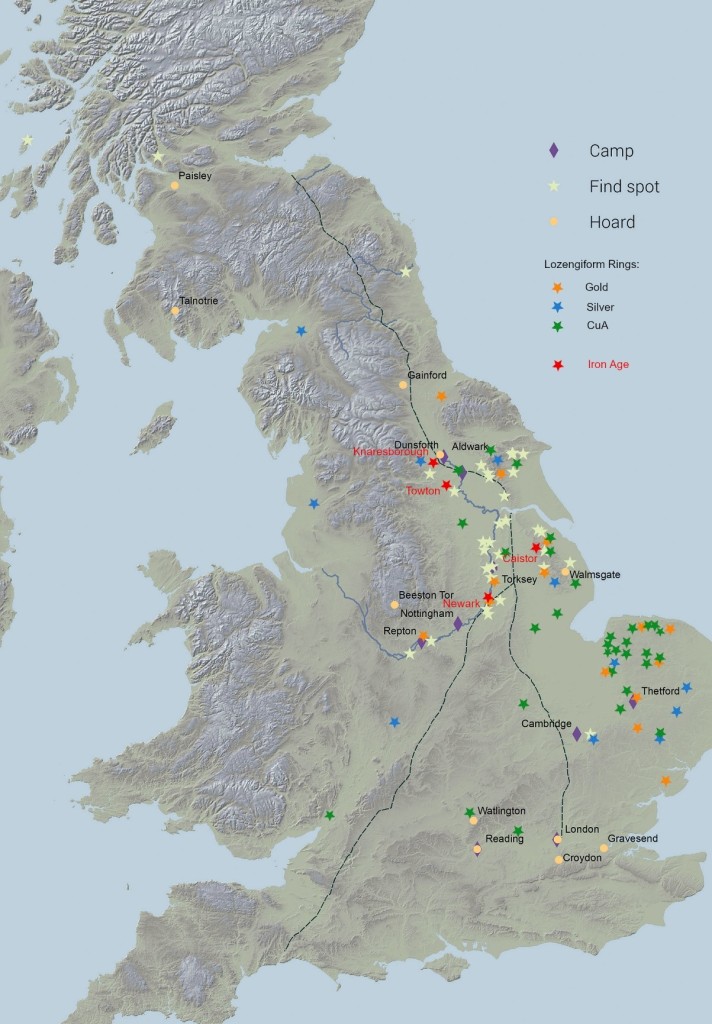
In addition, the pattern of ring finds within East Anglia perhaps provides the means of tracking activity – via an ‘artefactual signature’ (Hadley & Richards 2018, 1) – which has hitherto been difficult to achieve for this area (Hadley & Richards 2018, 14 & Fig. 6), although Scandinavian settlement is attested to by other jewellery finds (Kershaw 2013). However, more research will be needed to elucidate this further and is beyond the scope of this paper.
As has been previously discussed, the gold finds from Newark, Caistor/West Lindsey, Towton and Knaresborough all fit well with an association with the Great Army: located either on or near the Viking river highways of the Great Ouse and Trent Rivers, or by tributary streams, the four find spots (Fig. 21) would be unusual locations for Iron Age deposits where, as has been discussed, groupings of torcs – buried on slopes or prominent positions – is the norm. However, deposition locations close to streams and rivers, or in wetland environs has been noted as being typical of Scandinavian-style gold rings (Hårdh 1996; Kershaw 2019, 243; Raffield 2014).
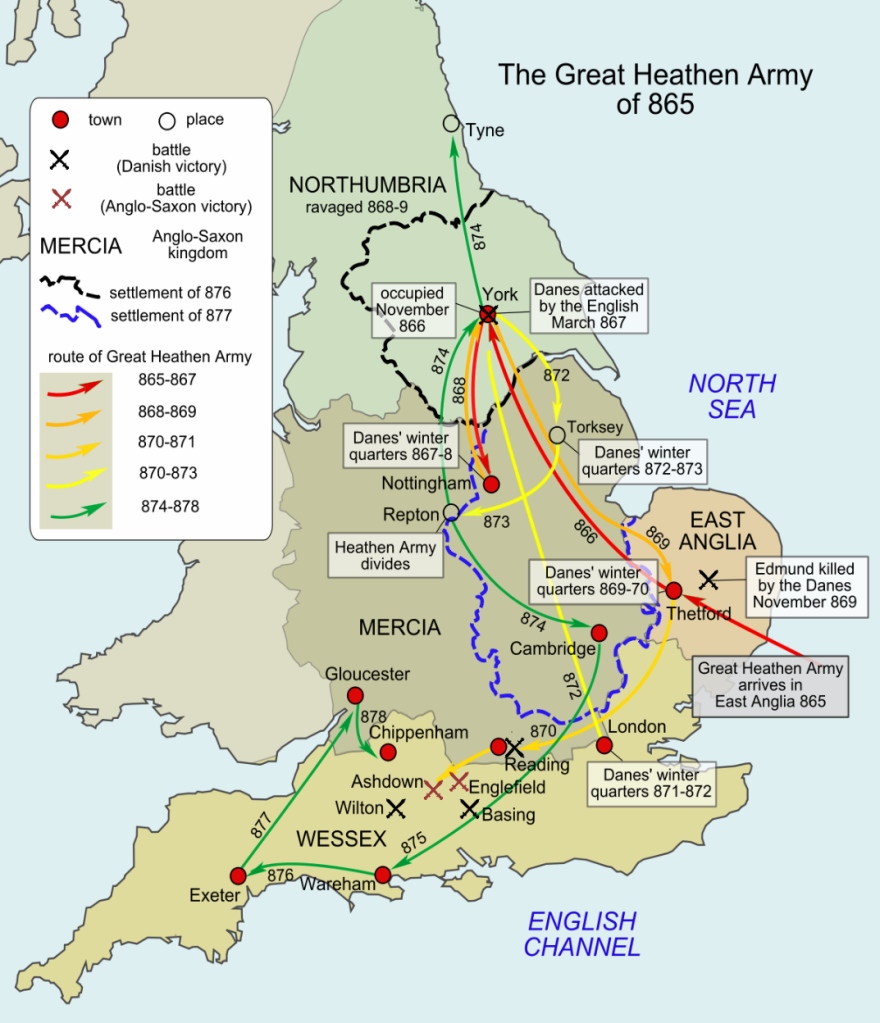
By looking at the location of the findspots, and the distribution of the lozengiform rings which relate to the Knaresborough ring, it may also be possible to narrow down a date for their deposition.
Dating the possible redeposited hoard
The Anglo-Saxon Chronicle records the dates and locations of the many waves of Viking Great Army incursion into England in the later 9th century. Starting in AD 865 in East Anglia, and moving north to York in AD 866, subsequent movements in the early 870s traversed eastern Britain, with Winter Camps established in Torksey, Repton, Thetford, Aldwark and Foremark (Hadley & Richards 2021). By the mid to late 870s, the Great Army had moved into south-west England and north from York into Northumbria, establishing a camp in the Coquet Valley (Kershaw et al 2023).
By comparing the Iron Age gold and lozengiform ring find locations to the known dates of the various Great Army movements, it may be possible to date the discovery and redeposition of the Iron Age gold. The findspots of Newark, Caistor/West Lindsey, Towton and Knaresborough most closely match the path of the Great Army in the early 870s. In addition, the absence of lozengiform ring finds in the south-west supports the theory that these artefacts predate the late 870s activity in this area.
Viking use of gold
Later 9th century England saw an upsurge in the use of gold (Blackburn 2007, 77-8), and the Great Army certainly had access to the metal in the 870s: ransom payments of ‘pure gold’ to the force are recorded on two occasions (Naylor and Standley 2022, 132). Gold, sometimes from comparatively antique sources, also forms a component of hoards and assemblages associated with the Army. The hack-gold fragment in the Watlington hoard of AD 878-9 has been noted above, and three pieces of hack-gold have also been catalogued from Aldwark, the site of a Great Army camp believed to post-date AD 876. Several complete gold objects were also recovered with the remains of the Leominster hoard, assumed to date to AD 879. However, the largest assemblage of gold is the assemblage from Torksey, the site of a winter camp occupied by the Army over AD 872-3.
At the most recent count (Hadley and Richards forthcoming, Randerson 2023, 97), nine fragments of hack-gold have been catalogued from Torksey. Seven gold ingots have also been recovered. Six of these are fragmented, with the complete example a folded, heavily-worked piece of bullion: ingots of this type have been characterised by Hårdh (2011, 284-5) as a ‘workshop ingot’, suitable for storing and conveying metal but not intended as a measured means of payment.
Additionally, four droplets of melted gold have also been recovered. By contrast, excavations at the 9th and 10th century trading site of Kaupang in Norway have only produced a single gold droplet. This has been characterised as showing the care with which gold was handled at the site (Pedersen 2016, 192), carrying the clear implication of more careless treatment at Torksey (Randerson 2023, 90 & 181-2).
More notably, in addition to two counterfeit gold coins, the Torksey camp has also produced five pieces of faked hack-gold. These are an unique class of object, made from gilded pieces of copper-alloy, and have not been identified at any other location (Blackburn 2011, 234). Three of these fakes are short sections of curved rod, whilst the other two take the form of copper ingots, gilded on all sides to create convincing forgeries. The existence of these ingots demonstrates that the faked hack-gold was intended to be used in metal-weight transactions, rather than be exchanged like the more conventional counterfeit coins.
However, forgeries like these could not have fooled anyone familiar with gold: when weighed, the lower density of the copper-alloy cores would have marked each piece out as either a clear fake or, at best, a heavily-debased alloy. This suggests that not only was gold plentiful and carelessly-handled in the camp, but that hacked fragments were common enough for forgeries to be passed without suspicion (Randerson 2023, 100). If activities at Torksey show a comparative glut of gold, with the metal used as a relatively new, unfamiliar currency, then the closing months of AD 872 may be good candidates for the finding of the Iron Age hoard en route between York and Lincolnshire.
As such, we would tentatively suggest that the finding and redeposition of the Iron Age hoard could be seen to have occurred within the early 870s, and related to the heightened localised interest in gold, as seen in the finds from Torksey, etc. The earth-moving activities associated with the transit of the army – for example, the creation of a temporary banked enclosure during the earliest Viking phase at Repton (Biddle 2023, 75) – is a tempting discovery scenario for the Iron Age gold work, although this can never be proved with certainty. It is equally possible that farming activity or chance find could also be responsible.
Viking deposition
In terms of deposition location, the finding of the Newark torc close to the River Trent, at a nodal transport point where a river crossing and road met, and the location of the Towton torcs within a stream are perhaps suggestive of a ritual/ceremonial offering. Previous finds from Newark, of a piece of gold ring (PAS NLM-1B0476) and a hacked silver wire bracelet (PAS NLM-1B89B2) from Hawton, near Newark (Hadley & Richards 2018, 10) might suggest the area was important. The deposition of a complete, 699g, gold torc at Newark would suggest an offering of quite some consequence. Similarly, the two arm rings from Towton were not cut up, but deposited entire and – at 132g in total gold alloy weight – would have been a significant offering.
The deposition of these complete pieces follows recognised patterns in Scandinavia: Hårdh (1996, 132) observes that Viking-Age gold objects are typically recovered either singly or in deposits only containing gold, and that they are also commonly found whole, without the fragmentation often seen in silver. Further to this, Kilger (2008, 292-3) has noted the significance of ‘wholeness’ which appears to have been attached to gold objects, particularly rings, in Viking-Age society.
The Newark and Towton torcs may have been seen to carry associations with sacredness and leadership, with gold rings described as suitable rewards for military followers (Ager 2011, 127-8): all three torcs, whilst clearly of unusual form, would still have been sources of considerable symbolic capital within a Viking force. The retention of these as complete rings suggests a connection to older, more traditional forms of exchange and social expression seen in Scandinavia, with Kershaw (2019, 243) speculating that the deposition of such rings in watery contexts involved a ritualised performance.
However, the apparent hacking of the Caistor/West Lindsey gold torc, and adaptation of the Knaresborough ring (from a terminal or torc) would suggest a far more prosaic, bullion related, outcome for these two objects, tied to the new economy of fragmentation and metal weight which developed in the later 9th century. It is impossible to know what happened to the rest of the torc/torc terminal from which the Knaresborough ring and Caistor/West Lindsey piece were cut, although it seems possible that it was fragmented and/or melted down and used as bullion or made into similar decorative items: for example, the weight of the Knaresborough ring, at 5g, would allow for around twenty such rings to have been made from a single terminal of 114g Netherurd terminal weight.
Lead trial strikings from Torksey suggest that there were two different dies being used to make imitative gold solidii of Louis the Pious at the camp (Hadley and Richards forthcoming). Whilst no coins from these dies have been identified, other imitative gold solidii were in circulation on the site, echoing the distribution of similar imitations across the borders of the Carolingian empire (Randerson 2023, 198-9; Coupland 2016, 264). It seems reasonable to suggest that two different imitative gold coins were being struck at Torksey (Randerson 2023, 196-201).
As such, the reprocessing of a large gold torc/torc terminal into discrete, individual pieces such as rings and coins would still connect to the notions of wholeness expressed by Kilger, albeit with smaller, less prestigious objects. It is tempting to read the evidence of the two Torksey dies as showing competition between factional leaders in the Great Army, with both producing coins to recruit followers and to enhance their influence and standing: once again, a connection can be seen to the notions of leadership and military service already outlined, with a gold torc providing a suitable symbolic source for the metal.
Although the precise answer is impossible to know, the apparent Dublin weight concordance of the Caistor/West Lindsey torc piece and association with a lead weight/gaming piece would certainly suggest a more practical secondary use for this artefact. Whilst we have suggested that coins may potentially have been manufactured from a torc, with the Knaresborough ring clearly cut from one, the comparative abundance of hack-gold and gold ingots at Torksey carries the definite implication of fragmentation and dispersal for much of the metal. This shows a very different treatment when compared to the Newark and Towton torcs.
The Chronicle records the Great Army splitting into two separate forces after overwintering at Repton in AD 873-4. Whilst it may be overly simplistic to directly link the contrasting uses of our proposed Iron Age hoard with this split, there might be a degree of connection. The Army is known to have been a conglomerate force, composed of separate factions, each drawn from different areas of origin (McLeod 2014). It is possible to suggest that the putative hoard was split up and distributed amongst these various groups, resulting in individual pieces being treated differently and deposited in separate locations. Intense fragmentation is not out of keeping with the metal economy practiced by the Great Army as a whole, and it is possible, as Kershaw (2019, 227) suggests, that the breaking-up of pieces reflects a shift in the status and function of gold caused by an increased availability of the metal. Paradoxically, a plentiful supply of gold rings amongst the Great Army may have contributed to at least one torc being seen less as a sacred ‘whole’ object and more as a resource to be broken down.
The past in the past?
Other comparatively antique objects have also been recovered from the camp at Torksey, connected with the Great Army’s occupation of the site. Amongst these are a collection of silver sceats, an early Anglo-Saxon wrist clasp converted into a brooch and, more notably, a fitting from a Merovingian sword scabbard. This last artefact dates from the late 6th or early 7th centuries and is unique in Britain: all other examples of this type have a relatively narrow distribution, centred on north-eastern France and the Ardennes (Randerson 2023, 158-9).
These objects were almost certainly brought to the site by the Army, with the sceats and scabbard fitting most probably collected from Frisia, the origin-point of many members of the force. Whilst the silver content of the coins would undoubtedly have made them attractive in their own right, the other artefacts appear to have also been seen as valuable, viable items, despite their age. A parallel can be seen in the presence of mounted crystal spheres in the late 9th century Leominster and Galloway hoards (Goldberg & Davis 2021). Similar spheres are commonly dated from the 5th to 7th centuries (Randerson 2023, 47).
Although the above examples can be seen as potential ‘heirloom’ items, more ancient objects and locations have also been connected with Insular Scandinavian activity. The reappraisal of the early 10th century Bride Street burial in Dublin established that a Bronze Age halberd was included amongst the grave goods, with the piece deliberately bent in a manner identical to the Viking-Age weapons in the assemblage (Harrison 2010, 145-6).
The use and exploitation of prehistoric or Roman sites by early medieval people has been studied by several authors (e.g. Williams 1997; Semple 2013). Some of this activity may, of course, merely have been a pragmatic reuse of resources: a pertinent example is the suggestion that the Torksey-type weights and gaming pieces were manufactured using lead gleaned from the Roman villa which formerly occupied the camp site (Hadley and Richards 2021, 107).
However, other actions have been seen as attempts to forge a link between incoming groups and a local past, appropriating talismanic items such as the Bride Street halberd to express authority and control (Harrison 2010, 147). Whilst the finders of our proposed Iron Age hoard cannot have had any idea of its actual age, they will almost certainly have recognised it as being ‘ancient’ as well as valuable. Whatever symbolic values they may have attached to this quality, the breaking up and reuse of the hoard fits with a pattern seen in other antique objects, with items from the past incorporated into everyday activities and used for various ritualistic and economic purposes.
Summary
This paper suggests that the Knaresborough ring, once thought of as an Iron Age example, may instead be evidence of Scandinavian-influenced discovery and modification of an Iron Age gold torc, in the later 9th century. We have offered a possible explanation for the form of the ring, its provenance and a reason for an unusual distribution of Iron Age artefacts found across the north and east of England. With two of the torcs having been nicked, a third nicked and cut down to a recognized Viking-Age weight and a fourth apparently modified to create a Scandinavian ring/earring, all have been found in locations not usually associated with Iron Age gold torc deposition.
However, we believe we have shown a correlation with the activities of the Viking Great Army in the late 9th century and as such suggest that these artefacts were discovered, altered and re-deposited by members of, or peoples related to, that same army. In conjunction with the distribution pattern of Scandinavian-influenced lozengiform rings and the known path of the army, the re-deposition of the Iron Age hoard – and making of the Knaresborough ring – appears to correspond with the movements of the Viking Great Army in the early 870s and so may also be of that date.
As such, we have possibly glimpsed an episode when the peoples of a millennium ago, uncovered objects from over a millennium earlier, and put them to use in their own time. What they understood of the antiquity of these objects, or how their thoughts about what they were affected their use of them, we shall never know. What we can probably say is that at some time in the later 9th century, the Vikings nicked and ‘nicked’ some Iron Age gold.
Acknowledgements
Firstly, we would like to thank Cat Jarman, who noticed the similarity of the Knaresborough ring to Viking examples at the same time we did. Work commitments did not allow her contribution to this paper beyond its initial stages, but Cat is very much included in this work in spirit.
Our grateful thanks also go to Glyn Hughes, Kevin Winter and the staff at the National Civil War Museum, Newark for kindly allowing us unrestricted access to the Newark torc. Lucy Creighton, Emily North and the staff of Yorkshire Museum are thanked for numerous discussions over the Knaresborough ring and for kindly photographing, and providing images of, the Towton torcs for us. Regional museums really are stars!
Our thanks also to Martin Foreman for discussions regarding the Caistor torc piece. We would also like to thank Dawn Hadley and Julian Richards for advance access to their forthcoming work.
We could not have completed this work without the team of folks who read this paper and commented on it: David Petts, Matt Knight, Kel Barrass and Giovanna Fregni are hugely thanked. All errors and omissions, however, remain the authors’ own.
Finally, we would like to thank the British Museum for releasing the unpublished 1994 Knaresborough ring data to PAS.
Appendix 1:
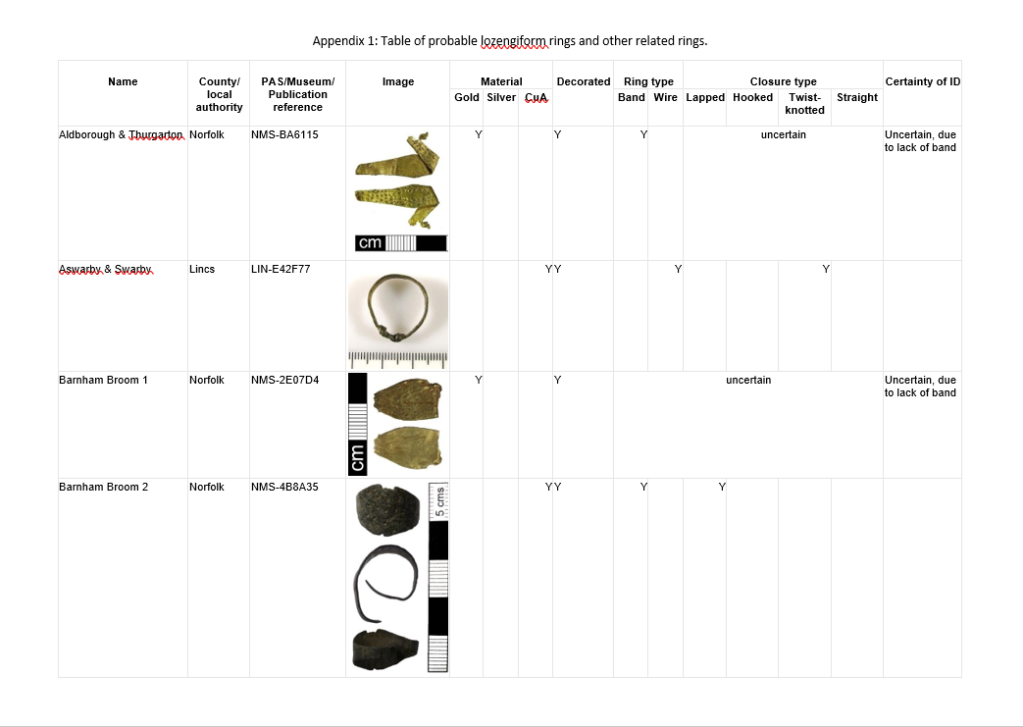


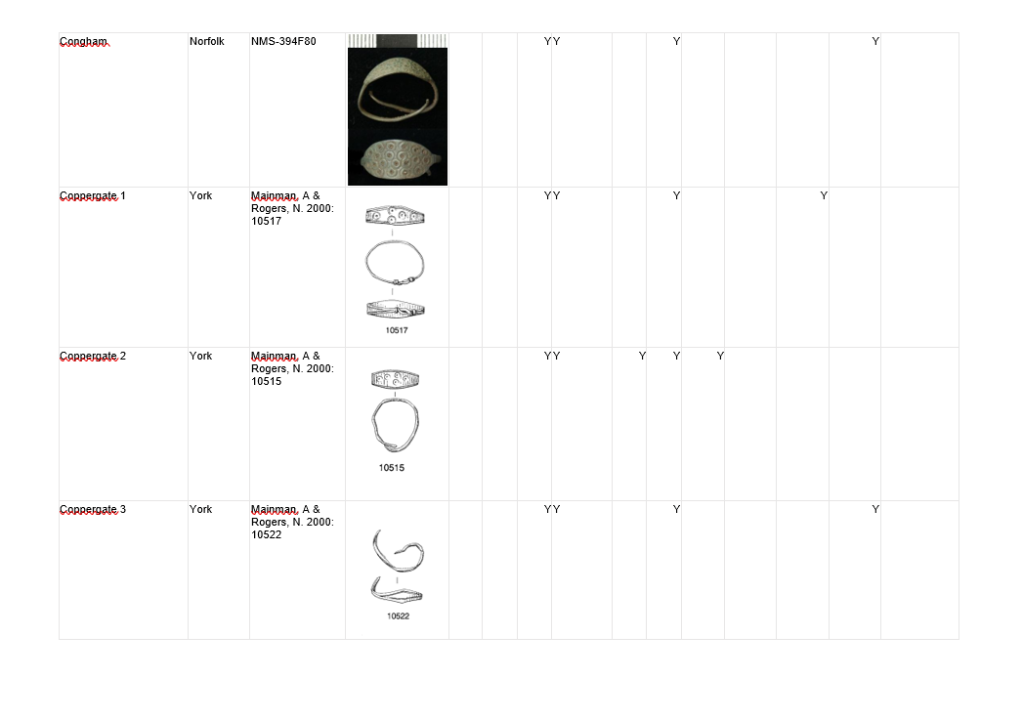

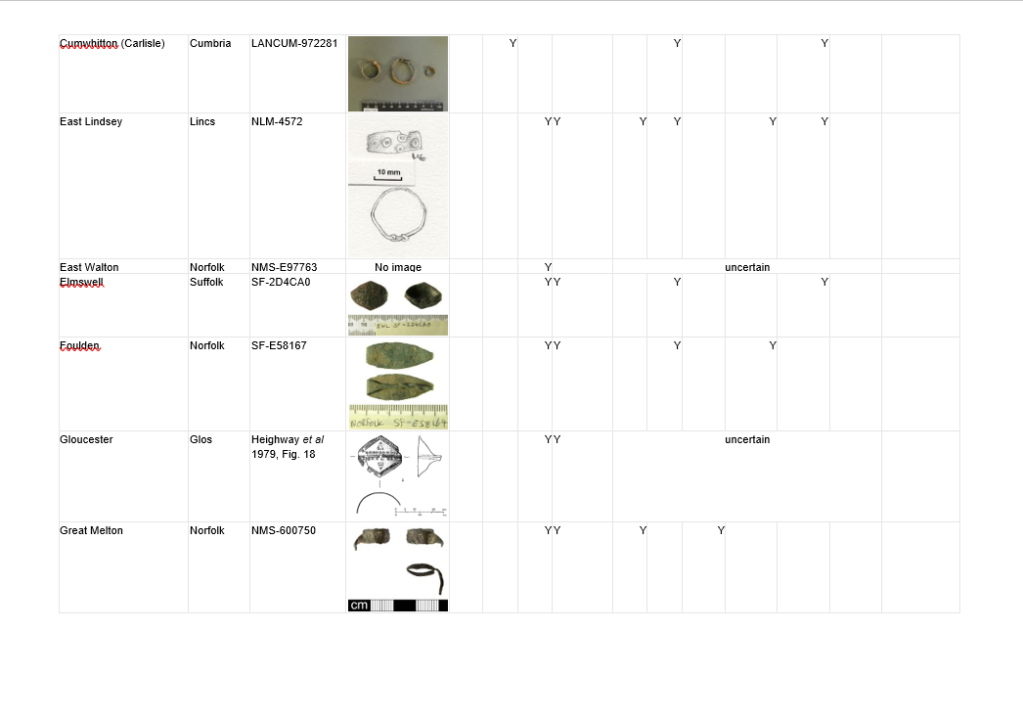
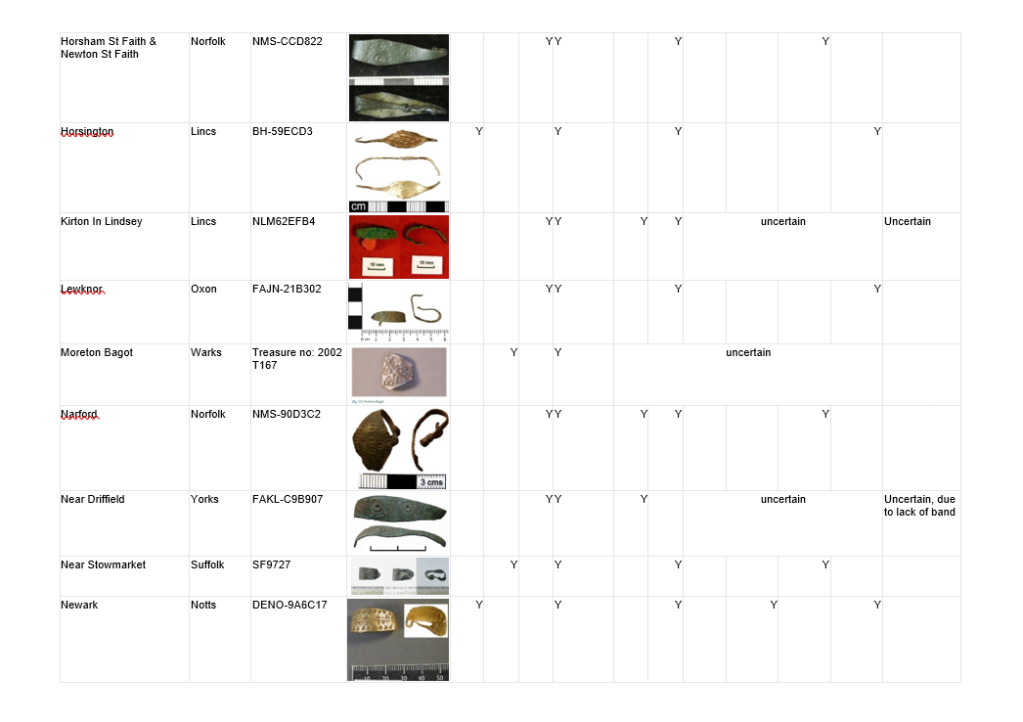
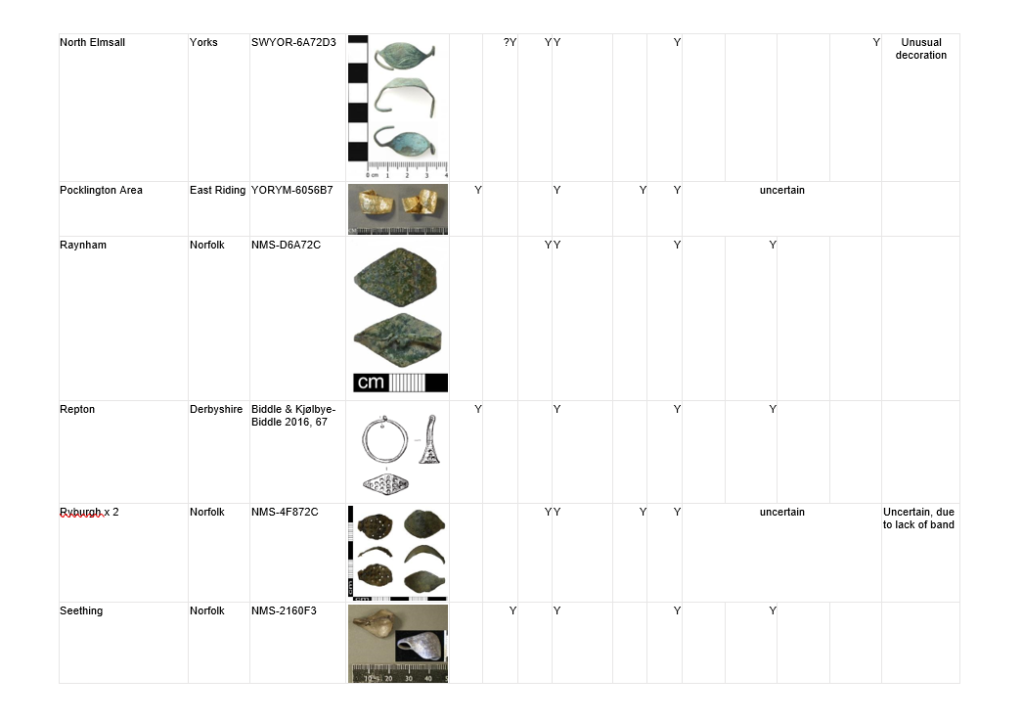

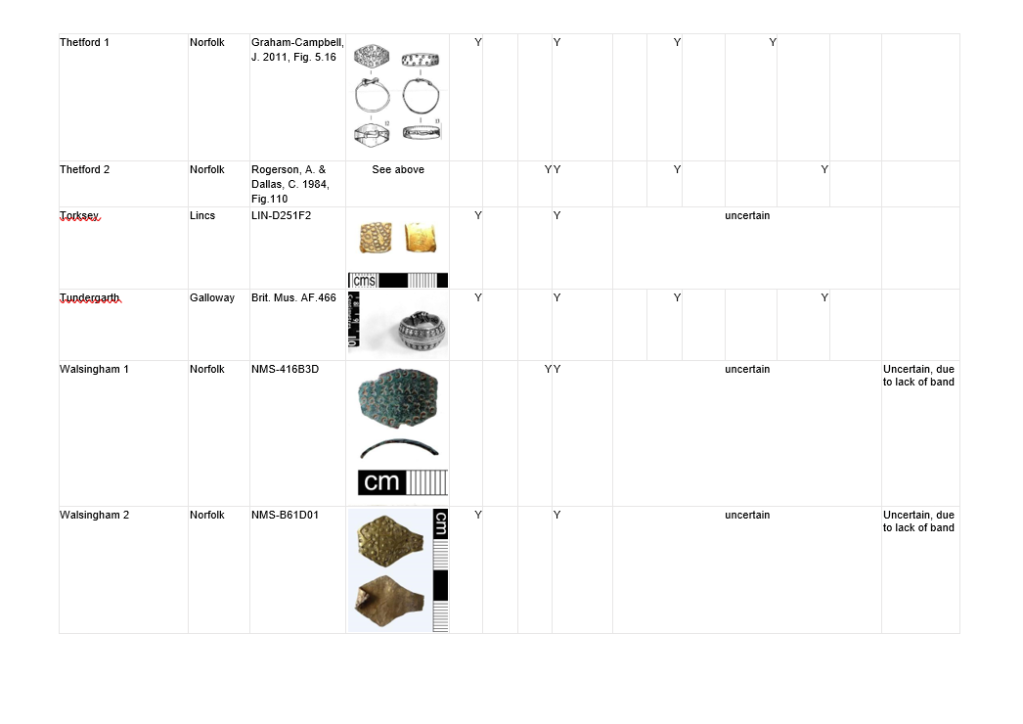
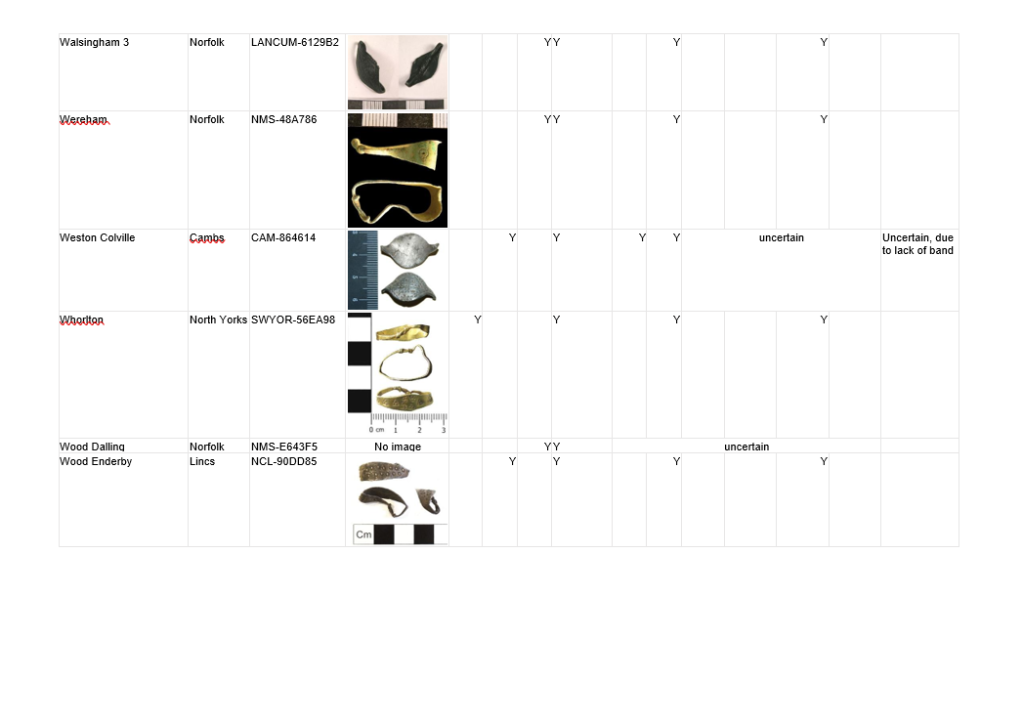
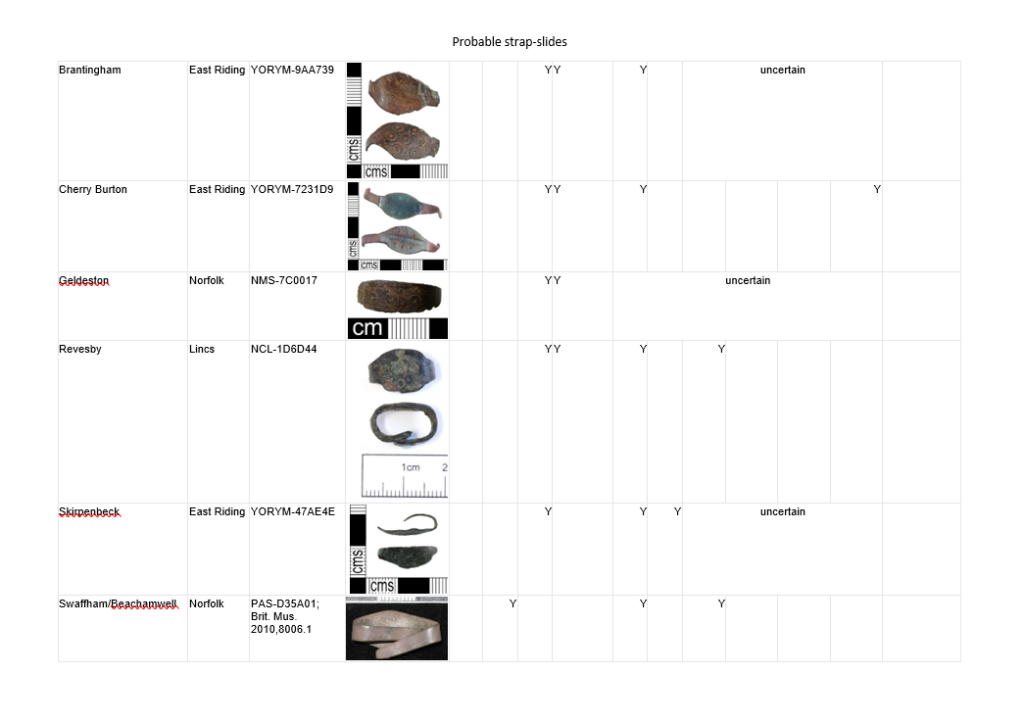

References:
Ager, B. 2011. A Preliminary Note on the Artefacts from the Vale of York Viking Hoard. In Abramson, T. (Ed.), Studies in Early Medieval Coinage Volume 2: New Perspectives. Woodbridge: The Boydell Press, pp. 121-134.
Atherton, R. 2016. The Newark Iron Age torc. Transactions of the Thoroton Society of Nottinghamshire. 120, 43-53
BBC Yorkshire. 2022. Celtic ruler’s ring goes under hammer for £36,000 at auction. https://www.bbc.co.uk/news/uk-england-york-north-yorkshire-63660018 [Accessed online 16/4/23]
Berganza jewellers. 2023. Viking gold stamped ring circa 9th -11th century. https://www.berganza.com/Viking-gold-stamped-ring-circa-9th-11th-century-AD.html [Accessed online 16/4/23]
Biddle, M. 2023. The Vikings at Repton Wintersetl og mindesmærke – winter camp and place of memory. In C. Hedenstierna-Jonson & I. García Losquiño (eds) Viking Camps: Case Studies and Comparisons, Routledge, 55-77.
Biddle, M. & Kjølbye-Biddle, B. 2016 Repton and the ‘Great Heathen Army’, 873–4. In J. Graham-Campbell, R. Hall, J. Jesch & D.N. Parsons (eds). Vikings and the Danelaw. Oxbow.
Blackburn, J. 2022. £30,000 Celtic ring was left in cupboard. The Times, 10th November 2022. https://www.thetimes.co.uk/article/30-000-celtic-ring-was-left-in-cupboard-tz2p0f62h [Accessed online 16/4/23].
Blackburn, M. 2007. Gold in England during the age of silver (eighth-eleventh centuries). In J. Graham-Campbell & G. Williams (eds) Silver Economy in the Viking Age. Walnut Creek,CA, 55-98.
Blackburn, M. 2011. ‘The Viking winter camp at Torksey, 872-3’ in M. Blackburn. Viking Coinage and Currency in the British Isles. British Numismatic Society Special Publication No.7, (London), 221-64.
Brailsford, J.W. 1971. The Sedgeford Torc. British Museum Quarterly 35(1), 16–19
Brailsford, J.W. and Stapley, J.E. 1972. The Ipswich Torcs. Proceedings of the Prehistoric Society 38, 219-234
Coupland, S. 2016. Recent Finds of Imitative Gold Solidi in the Netherlands. The Numismatic Chronicle 176, 261-269.
Farley, J., Gilmore, T., Sutherland, Z. & Nicolls, A. 2018. ‘The Leekfrith torcs’ Transactions of the Staffordshire Archaeological and Historical Society 50, 110 – 114.
Feachem, R.W. 1958. The ‘Cairnmuir’ hoard from Netherurd, Peebleshire. Proceedings of the Antiquaries of Scotland 91, 112–116
Foreman, M. 2013. Report on the West Lindsey torc. https://finds.org.uk/database/artefacts/record/id/548462 [Accessed online 16/4/23]
Fox, C. 1958. Pattern and Purpose: A Survey of Early Celtic Art in Britain. Cardiff: The National Museum of Wales.
Goldberg, M. & Davis, M. 2021. The Galloway Hoard: Viking-age Treasure. Edinburgh: National Museums Scotland.
Graham-Campbell, J. 1978. The Viking-age silver and gold hoards of Scandinavian character from Scotland. Proceedings of the Society of Antiquaries of Scotland, 107, 114-135.
Graham-Campbell, J. 2011. The Cuerdale Hoard and Related Viking-age Silver and Gold from Britain and Ireland in the British Museum. British Museum Research Publication 185. London: Trustees of the British Museum.
Graham-Campbell, J. & Batey, C. 1998. Vikings in Scotland: An archaeological survey. Edinburgh: Edinburgh University Press.
Graham-Campbell, J. & Williams, G. (eds). 2007. Silver Economy in the Viking Age. Walnut Creek, CA: Routledge.
Griffiths, D. 2003. Markets and ‘Productive’ Sites: A View From Western Britain. In Pestel, T. and Ulmschneider, K. (Eds.), Markets in Early Medieval Europe: Trading and ‘Productive’ Sites, 650-850. Oxford: Windgather Press.
Hadley, D. & Richards, J. 2018. In Search of the Viking Great Army: Beyond the Winter Camps. Medieval Settlement Research. 33, 1-17.
Hadley, D. & Richards, J. 2021. The Viking Great Army and the Making of England. London: Thames & Hudson.
Hadley, D. & Richards, J. Forthcoming. The Viking Great Army: From tents to towns. Oxford: Oxford University Press.
Hårdh, B. 1996. Silver in the Viking Age: A Regional-Economic Study. Stockholm: Almqvist & Wiksell International.
Hårdh, B. 2011. Viking-Age Silver Hoards and Cultural Layers. In G-C. James, S. M. Sindbæk, & G. Williams (eds), Silver economies, monetisation and society in Scandinavia, AD 800-1100. 281-296. Aarhus: Aarhus Universitetsforlag.
Harrison, S.H. 2010. Bride Street revisited – Viking burial in Dublin and beyond. Medieval Dublin X, 126-152.
Hawkes, C.F.C. 1936. The Needwood Forest Torc. The British Museum Quarterly 11(1), 3-4
Hunter, F. 2018. The Blair Drummond (UK) hoard: Regional styles and international connections in the later Iron Age. In R. Schwab, P-Y. Milcent, B. Armbruster & E. Pernicka (eds), Early Iron Age Gold in Celtic Europe: Science, technology and Archaeometry. Proceedings of the International Congress held in Toulouse, France, 11-14 March 2015, 431-440. Rahden: Verlag Marie Leidorf GmbH
Iron Age Coins in Britain (IACIB). 2022. Database: https://iacb.arch.ox.ac.uk/ [Accessed online 16/4/23]
Jarman, C., Biddle, M., Higham, T. & Bronk Ramsey, C. 2018. The Viking Great Army in England: new dates from the Repton charnel. Antiquity 92, 183-199.
Jope, M. 2000. Early Celtic Art in the British Isles. Oxford: Oxford University Press
Joy, J. 2018. Snettisham: Shining new light on old treasure. Jewellery History Today 31, 3-5
Katori, M., Io, T. & Ibusr, K. 2006. Kinko no dento giho [A manual of traditional gold/metal work].Tokyo: Rikogakusha Shuppan, [S.l.].
Kershaw, J.F. 2013. Viking Identities: Scandinavian jewellery in England. Oxford: Oxford University Press.
Kershaw, J. 2019. Gold as a Means of Exchange in Scandinavian England (c.ad 850–1050), in J. Kershaw (ed) Silver, Butter, Cloth: Monetary and Social Economies in the Viking Age, 227–250. Oxford Academic Press.
Kershaw, J. 2020. Metals and exchange in Viking-age Yorkshire: the contribution of single finds. In G. Williams (ed) A riverine site near York: A possible Viking camp. 113-127. British Museum Research Publication 224.
Kershaw, J., Jarman, C., Weber, H. & Horton, M. 2023. The Viking Great Army north of the Tyne: A Viking camp in Northumberland? In C. Hedenstierna-Jonson & I. García Losquiño (eds) Viking Camps: Case Studies and Comparisons, Abingdon-on-Thames, UK: Routledge, 96-116.
Kilger, C. 2008. Wholeness and Holiness: Counting, Weighing and Valuing Silver in the Early Viking Period. In D. Skre (ed), Means of Exchange: Dealing with Silver in the Viking Age. Kaupang Excavation Project Publication Series Vol. 2, Norske Oldfunn XXII. Aarhus: Aarhus University Press, 253-325.
Knight, M.G., Boughton, D. & Wilkinson, R. (eds). 2019. Objects of the Past in the Past: Investigating the Significance of Earlier Artefacts in Later Contexts. Oxford: Archaeopress.
Kruse, S. & Graham Campbell, J. 2011. Classification and discussion of the objects from the Cuerdale Hoard: Part 1 Ingots. In J. Graham-Campbell (ed) The Cuerdale Hoard and Related Viking-age Silver and Gold from Britain and Ireland in the British Museum. British Museum Research Publication 185. London: The British Museum.
Machling, T. & Williamson, R. 2018a. ‘Up Close and Personal’: The later Iron Age Torcs from Newark, Nottinghamshire and Netherurd, Peeblesshire. Proceedings of the Prehistoric Society 84, 387–403.
Machling, T. & Williamson, R. 2018b. Blog: Did Vikings ‘nick’ the Newark torc?. May 2018. https://bigbookoftorcs.com/2022/05/17/did-vikings-nick-the-newark-torc/ [Accessed online 16/4/23]
Machling, T. & Williamson, R. 2018c. Blog: Did Vikings ‘nick’ the Newark torc…and the West Lindsey and Towton torcs too?. December 2018. https://bigbookoftorcs.com/2022/05/17/did-vikings-nick-the-newark-torc-and-the-west-lindsey-and-towton-torcs-too/ [Accessed online 16/4/23]
Machling T & Williamson R. 2019a. ”Damn clever metal bashers”: The thoughts and insights of 21st century goldsmiths, silversmiths and jewellers regarding Iron Age gold torus torcs in C. Gosden, H. Chittock, C. Nimura & P. Hommel (eds), Art in the Eurasian Iron Age: Context, connections, and scale. Oxford: Oxbow Books.
Machling, T. & Williamson, R. 2019b. ”Cut and shuts”: The reworking of Iron Age gold torus torcs, Later Prehistoric Finds Group Newsletter 13 (Summer 2019), 4-7
Machling, T., Williamson, R. & Hallam F. 2019c. Going round in circles: the relief decoration of Iron Age gold torcs. PAST: The Newsletter of the Prehistoric Society 93 (Autumn 2019), 3–5.
Machling, T. & Williamson, R. 2020a. Investigating the manufacturing technology of later Iron Age torus torcs. Historical Metallurgy. 52, 2 (for 2018), 83-95.
Machling, T. & Williamson, R. 2020b. A rediscovered Iron Age torus torc terminal fragment from ‘Near Stowmarket’, Suffolk. February 2020. https://bigbookoftorcs.com/2020/02/02/near-stowmarket-torc/ [Accessed online 16/4/23]
Machling, T. & Williamson, R. Forthcoming. An unusual pattern of Iron Age gold torc finds from Staffordshire.
McLeod, S. 2014. The Beginning of Scandinavian Settlement in England: The Viking ‘Great Army’ and Early Settlers, c. 865-900. Studies in the Early Middle Ages 29. Turnhout: Brepols Publishers.
Naylor, J & Stanley, E. 2022. The Watlington Hoard: Coinage, kings and the Viking Great Army in Oxfordshire, AD875–880. Oxford: Archaeopress.
Noonans. 2022. Coins, historical medals & antiquities catalogue for auction sale, 15th-16th November 2022. https://www.noonans.co.uk/auctions/calendar/661/ Catalogue: https://issuu.com/noonansauctions/docs/coins_15-16_nov_22 [Accessed online 10/4/24]
Painter, K. S. 1971. An Iron Age gold-alloy torc from Glascote, Tamworth, Staffs. Transactions of the South Staffordshire Archaeological and Historical Society 11, 1969-70, 1-6.
Paterson, C., Parsons, A.J., Newman, R.M., Johnson, N. & Howard Davis, C. 2014. Shadows in the Sand: Excavation of a Viking Age Cemetery at Cumwhitton, Cumbria. Oxford: Oxbow.
Pedersen, U. 2016. Into the Melting Pot: Non-ferrous Metalworkers in Viking-period Kaupang. Aarhus: Aarhus University Press.
Portable Antiquities Scheme (PAS). 2005. Torc from near Newark, Nottinghamshire (2005 T52). https://finds.org.uk/database/artefacts/record/id/751306 [Accessed online 16/4/23]
Portable Antiquities Scheme (PAS). 2022. Iron Age gold finger rings. https://finds.org.uk/database/search/results/broadperiod/IRON+AGE/material/23/sort/objectType/objectType/FINGER+RING [Accessed online 16/4/23]
Portable Antiquities Scheme (PAS). 2023. Record ID: BM-CDF17E. https://finds.org.uk/database/search/results/q/BM-CDF17E [Accessed online 10/4/24]
Raffield, B. 2014. ‘A River of Knives and Swords’: Ritually Deposited Weapons in English Watercourses and Wetlands during the Viking Age. European Journal of Archaeology, 17 (4), 634-655.
Randerson, M.J. 2023. “A Winter’s Tale”; A Comparative Analysis of the Artefact Assemblages from the winter camps of the Viking Great Army at Torksey and Aldwark. Unpublished, University of York. MPhil. Available via White Rose e-Theses: https://etheses.whiterose.ac.uk/33974/, embargoed until 31/1/25.
Semple, S. 2013. Perceptions of the Prehistoric in Anglo-Saxon England: Religion, Ritual, and Rulership in the Landscape. Oxford: Oxford University Press
Stead, I.M. 1991. The Snettisham treasure: Excavations in 1990. Antiquity 65, 447–64
Williams, H. 1997. Ancient Landscapes and the Dead: The Reuse of Prehistoric and Roman monuments as Early Anglo-Saxon Burial Sites. Medieval Archaeology 41, 1-32.
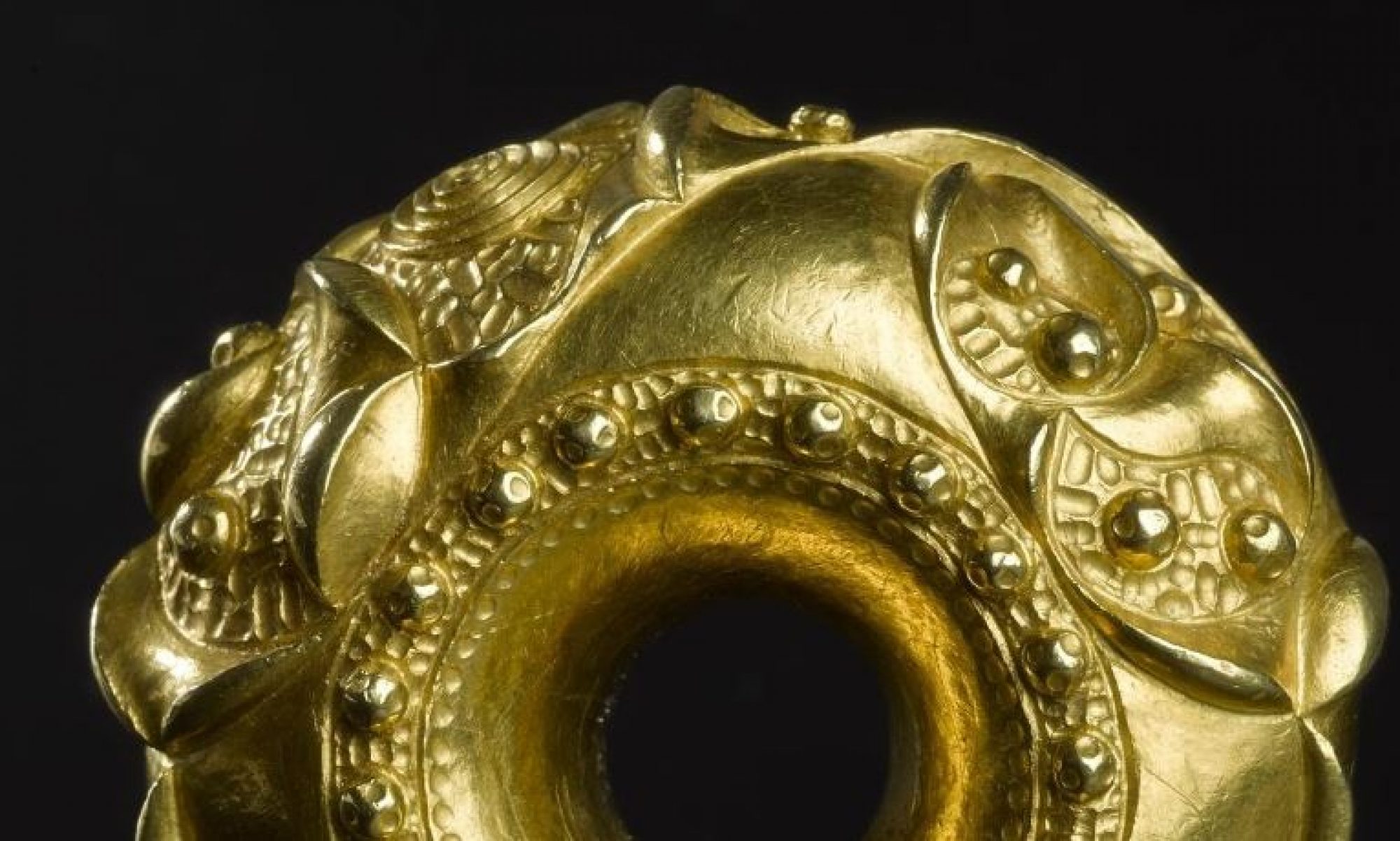
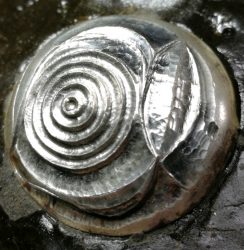

One Reply to “”